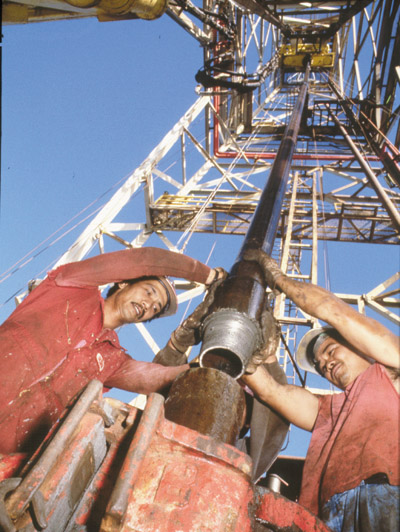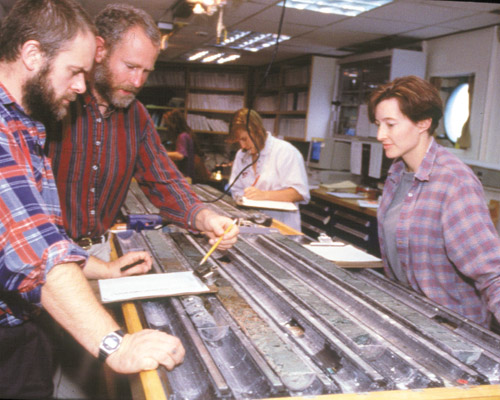



ďODP shrinks the world.
Itís one of the largest geoscience programs on Earth, and, with many countries
participating in its efforts, itís truly larger than the sum of its parts.Ē
Bruce Malfait, director
of the Ocean Drilling Program at the National Science Foundation
Although likely to spur debate from mathematicians, Malfaitís statement captures the essence of the success of the Ocean Drilling Program (ODP). Forming an international partnership has allowed scientists to understand far more about the evolution and structure of Earth than the traditional single investigator approach. Its structure has not only provided data leading to better understanding of solid earth and environmental conditions, but also promoted interdisciplinary research and education. ODP has fostered an approach that could be used to understand current and future environmental and scientific policy issues, which often do not follow national boundaries.
In 2003, ODPís research vessel, the JOIDES Resolution, will set off on ODPís final leg. The winding down of the program was scheduled many years ago, when scientists realized that ocean drilling would continue to evolve and a new program would be needed to continue advancing deep ocean research. The international community is now working together to implement a successor to ODP, the Integrated Ocean Drilling Program (IODP). This new program will build on the partnerships and research advances made during the Ocean Drilling Program and will seek to further advance understanding of Earth, its history and its future.
[Above: JOIDES Resolution can deploy up to 30,000 feet of drill string. Pictured here are members of the JOIDES Resolution crew. On each cruise, which lasts about two months, as many as 50 crew members and 50 scientists work aboard the research vessel. All images were provided courtesy of the Ocean Drilling Program.]
How to
herd cats
In many international efforts, science is lost in the shuffle as nations
with different agendas, budgets, and cultures attempt to unite. ODPís scientific
advisory system and history has helped it overcome these obstacles.
ODP has its beginnings in the Deep Sea Drilling Program (DSDP) initiated in 1968. Best known for its research on plate tectonics and sea-floor spreading, DSDP was the first scientific effort to sample the global sea floor by deep-ocean coring and downhole logging. Initially a U.S.-sponsored operation, DSDP quickly grew to include five additional countries. The international earth science community developed a new ocean drilling program in the 1980s when DSDPís research vessel, Glomar Challenger, reached the end of its sea life.
The ODP began in 1985 with the retrofitting of the drill ship now known as the JOIDES Resolution. The program also gained new international partners and now has 22 members worldwide. Each partner or international member pays an annual fee to ODP. In turn, they can send scientists to work on the JOIDES Resolution, contribute to the scientific steering panels and other advisory panels, submit drilling proposals, use ODP equipment, receive copies of the programís annual initial results and scientific results volumes, and participate in the student trainee program.
The ODP Council, with representatives from all partners, is a forum in which the members can exchange information and views on the programís finances, management and goals. The National Science Foundation coordinates the programís finances, and contracted as manager the Joint Oceanographic Institutions (JOI), a consortium of 16 universities. JOI turns 25 this year. Through subcontracts from JOI, Texas A&M University is the science operator, maintaining the JOIDES Resolution, and the Lamont-Doherty Earth Observatory is the logging operator, developing the Site Survey Data Banks.
Science
steers the ship
The partner nations are involved in both the proposal submission and
review process via ODPís scientific advisory structure, the Joint Oceanographic
Institutions for Deep Earth Sampling (JOIDES). Individuals, groups and
established programs from industry, government and academia submit proposals.
Nearly 200 scientists worldwide serve on panels that review proposals,
evaluating their scientific merit, links to ODP goals, and logistical and
safety considerations. After research proposals are selected, a JOIDES
committee plots a year-long course for the JOIDES Resolution to the research
sites.
The laboratories on the JOIDES Resolution illustrate the interdisciplinary work conducted onboard. ODP recently added a microbiology laboratory that complements the sedimentology, paleontology, petrology, geochemistry, geophysics and paleomagnetics laboratories. This multidisciplinary and interdisciplinary approach has produced data relevant to understanding geoscience issues that affect society, including climate change, natural hazards and resource development.
Climate
change
ODP has helped to advance our understanding of natural climate variability,
particularly rapid climate changes. Various research legs have focused
on sea-level change off the coast of New Jersey, rapid climate change records
in the Santa Barbara basin, and past shifts from glacial to warmer climates.
 [Left:
In the core laboratory onboard the JOIDES Resolution, researchers observe
each coreís macroscopic and microscopic properties. They define terminology
that will provide a common geological language for scientists from different
countries and institutions. Above: ODP recently installed an interdisciplinary
microbiology laboratory aboard JOIDES Resolution.]
[Left:
In the core laboratory onboard the JOIDES Resolution, researchers observe
each coreís macroscopic and microscopic properties. They define terminology
that will provide a common geological language for scientists from different
countries and institutions. Above: ODP recently installed an interdisciplinary
microbiology laboratory aboard JOIDES Resolution.]
Research has also focused on sudden, dramatic climate changes, such as those associated with the mass extinctions at the Cretaceous-Tertiary boundary. Drilling in the Atlantic Ocean offshore Florida revealed cores with sedimentary layers that provide support for the long-standing theory that a large extraterrestrial object slammed into Earth and caused the extinctions. The cores showed the progression from a collision ó silica-rich globules produced by a large meteorite impact and rock debris from the Chicxulub crater ó to a world with very few microorganisms, and then to a repopulation of the region and an eventual return to normal conditions.
An upcoming cruise, Leg 199, will continue climate research, focusing on the equatorial current system. One site will be drilled specifically to study how ocean chemistry and circulation evolved in response to high-latitude cooling and glaciation during the Eocene to Oligocene transition. Knowledge of past climate changes will help scientists understand current observed and projected climate change.
Natural
hazards
Deep-ocean drilling has expanded our knowledge of plate tectonics and,
as a result, of large-scale earthquakes. ODP has sampled about a dozen
subduction zones and studied the fluxes of these systems as well as the
composition of fluids and the role fluids play in subduction zone evolution.
Research legs have examined the role of water within fault zones, particularly
the effect of permeability and fluid pore pressure at the boundary between
the North American and Caribbean plates.
Real-time information from deep below the sea floor will fill in information gaps for future seismic study, as ODP participates in a global effort to increase the number of permanent geophysical observatories on the ocean floor. This takes advantage of both past and future ODP cruises. A pilot project used a borehole created during a previous ODP cruise near Oahu to deploy seismic instruments into the sea floor. The JOIDES Resolution has installed other stations during ODP cruises, including one in the Indian Ocean during a leg designed to research earthquakes. These and future stations will provide global coverage for research on the processes that cause earthquakes.
Gas hydrates
Gas hydrates are crystallized gas and water that form under high pressure
and low temperatures in the deep sea. These natural gas reserves could
potentially contain as much energy as all other forms of fossil fuels combined.
But they are poorly understood. In most cases, the gas is methane; however,
some hydrates have been recovered with high concentrations of carbon dioxide,
hydrogen sulfide and other heavier hydrocarbons.
In 1995, ODP drilled into a gas hydrate field in the Blake Ridge off
the coast of North Carolina. Scientists were able to take and maintain
samples of hydrates at the in situ, high-pressure conditions in which the
hydrates formed.
From this study, the scientists have estimated that the Blake
Ridge contains about 2.3x1015 cubic feet of methane ó enough to supply
U.S. needs for more than 100 years.
More research on hydrates will occur next summer at Hydrate Ridge, offshore Oregon, during Leg 204. Drilling will focus on obtaining cores to better understand the physical and chemical mechanisms of hydrate formation and estimate hydrate volumes. This data should help researchers evaluate the economic potential of gas hydrates as a resource.
Education
ODP has played a major role in education, through both its cores and
cruises. About 20 percent of the scientists on the JOIDES Resolution are
graduate students who gain experience in drilling and research and in working
on teams. ODP has recently started an undergraduate student trainee program
in which undergraduate students work under a mentorís guidance and sample
the variety of scientific and technical activities of ocean drilling.
ODP databases, core repositories and micropaleontological reference centers are available to all scientists. The ship has taken more than 138 kilometers of core, resulting in more than 1 million samples spanning both the Cenozoic and Mesozoic eras. This information is available to students and researchers worldwide.
ďThe opportunities for ocean research are enormous, but the greatest rewards lie in working much more closely and actively with our colleagues in the solid earth, atmospheric and biologic sciences and focusing attention on the atmosphere-water-human-land system,Ē says JOI President Steven Bohlen. ďTogether we can produce scientific results that will have significant impact on public policy.Ē
Integrated Ocean Drilling Program
The Integrated Ocean Drilling Program (IODP) is scheduled to begin in October 2003. An international working group is still examining scientific and logistical options for implementing IODP.
How will IODP differ from the Ocean Drilling Program (ODP)? The main
advances will occur in the research vessels. IODP will use two ships, a
riser vessel currently under construction in Japan and a nonriser ship
sponsored by the United States.
With the riser drill ship, scientists will be able to drill into areas
where safety concerns had precluded drilling, such as continental margins
that contain oil and gas deposits, and in regions with thick sediment sections,
fault zones and unstable formations. Additional platforms, including those
to drill in shallow water and ice-covered regions, have been recommended
in the planning for the nonriser vessel. To complement the additional onboard
capabilities, IODP will also enhance shore-based facilities.
The international working group is also examining ways to expand partnerships with other international programs and industry. The collaborations could come in the form of jointly sponsored workshops, shared technology and equipment, and drilling proposals to address high-priority scientific objectives. Funding for the program is still under discussion. The United States and Japan intend to be equal partners, while other international partners together may provide one-third of the total costs.
Three areas of research have been identified for IODP: the deep biosphere and the sub-seafloor; environmental change and processes and their effects; and solid Earth cycles and geodynamics
As IODP and its partners grow, research goals will continue to evolve,
likely into issues that we are just beginning to understand with information
gained during ODP. For more information on the IODP, visit
www.iodp.org
 |
Geotimes Home | AGI Home | Information Services | Geoscience Education | Public Policy | Programs | Publications | Careers |